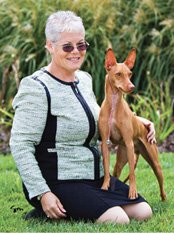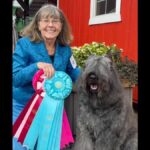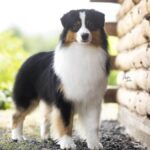Interview with Hound Group Breeder Jerri Gates – D’LEA Cirnechi
Where do I live? How many years in dogs? How many years as a breeder?
d’Lea Cirnechi – Jerri Gates: I’m currently in North Central Texas, but may be looking to relocate sometime in the next year or so. I started with Pharaoh Hounds in 1984, and my first Cirneco dell’Etna joined us in 1998. My first litter was of Pharaohs, born in 1998, and my first Cirneco litter was born in 2004.
What is my kennel name? How many dogs do I currently keep?
d’Lea Cirnechi – Jerri Gates: My mentor and original breed partner always said that her foundation girl, “Lea,” was the reason for our involvement in the breed. We came up with d’Lea as a result. I currently have 11 Cirnechi that live with me, which sadly includes several geriatrics.
Which show dogs from the past have been my noteworthy winners?
d’Lea Cirnechi – Jerri Gates: My foundation male, Speugippo, has been my once-in-a-lifetime show dog. “Pippo” was a complete natural and really didn’t need me in the ring to guide him. In our early endeavors with the “rare breed organizations,” he seldom won anything less than Best in Show. Unfortunately, due to age-related health issues, he was unable to compete once the breed was accepted into the AKC Hound Group.
Which have been my most influential sires and dams?
d’Lea Cirnechi – Jerri Gates: My most influential sire was Pippo, not just for me but for others as well. His name is in the pedigrees of many of the top-winning dogs, ever since our breed’s inception in the Hound Group.
Pippo’s daughter has been my most influential and successful dam. Not only was “Kia” a natural show dog like her father, doing her fair share of winning in both the show ring and the coursing field, she also produced 13 champions (out of 18 puppies).
Can I talk a bit about my facilities? Where are my puppies whelped? How are they raised?
d’Lea Cirnechi – Jerri Gates: My home is my facility. The dogs all live in the house with me, and pretty much have the run of the furniture. (Not only piled on the couch, but they like to perch on the back of the chair to have “sentry” duty, watching out the front window.) My whelping box is in my bedroom, and they get moved to the puppy pen in the living room where they start to interact with the rest of the crew. All of the puppies undergo Early Neurological Stimulation (ENS), then get quite a bit of socialization with my wonderful veterinary clinic staff and with friends while attending shows once they’re old enough.
What is my “process” for selecting show puppies? At what age do I make my decisions?
d’Lea Cirnechi – Jerri Gates: I start taking stacked pictures as soon as they are able to stand, plus just watching them while at play and exploration. It’s a long process to not only find the one that has what you are looking for structurally, but also the one that has that special personality that would excel in showing. I try to have my decision made on which one I plan to keep by 8 weeks, but also to match which puppy goes to which home.
How do I prepare my pups for the show ring? Does my breed require any special preparation?
d’Lea Cirnechi – Jerri Gates: Socializing them at shows has the added benefit of preparing them with people, other dogs, and the ring equipment. We play-train them to walk up and down on the ramp to get them comfortable with it.
Can I share my thoughts on how my breed is currently presented in the show ring?
d’Lea Cirnechi – Jerri Gates: I have mixed feelings on this. I love that most are shown on a free-stack, but I am disappointed that the parent club recommends they be walked for movement. This is a functional, working Hound, not a Toy breed, and their movement should reflect this.
Are there any health-related concerns within my breed? Any special nutritional needs?
d’Lea Cirnechi – Jerri Gates: Being a “primitive” breed, they are healthy by many standards. As such, I hope to see it stay that way. Health testing can aid in finding if there are any conditions that we need to be concerned about. A handful of breeders perform many of the available tests done on our dogs, for nothing more than to build a database for future reference.
In my opinion, is my breed in good condition overall? Any trends that warrant concern?
d’Lea Cirnechi – Jerri Gates: I believe we are pretty steady as a breed, and I see the dogs becoming more consistent—but there is always room to improve. My main concern isn’t with the breed, but with the continued lack of cooperation within the membership of the breed community.
Is my breed well-suited to be a family dog? Who are the best candidates to own my breed?
d’Lea Cirnechi – Jerri Gates: They do very well as a family pet, or with a single owner. They are a very adaptable breed. I do prefer that my homes have some experience in dogs, particularly with Hounds.
Do I feel that my breed is supported by a sufficient number of preservation breeders?
d’Lea Cirnechi – Jerri Gates: Since this is a fairly new breed to the US, there are relatively few breeders. Many of us do support each other in all aspects within our breeding programs and with our successes at events.
For a bit of fun, what’s the most amusing thing I’ve ever experienced with a Hound?
d’Lea Cirnechi – Jerri Gates: The most amusing was probably when I decided to try Obedience. My Pharaoh Hound, “Jack,” was great at getting his CD, and we even placed in the Top 3 for two of the qualifying legs. Since we were already entered, I decided to go for the “insurance leg.” Well, he must have known this and decided that he was “done.” On the recall exercise, he acted as though he didn’t hear me, and that the voice was coming from the ceiling. We didn’t qualify that day.










